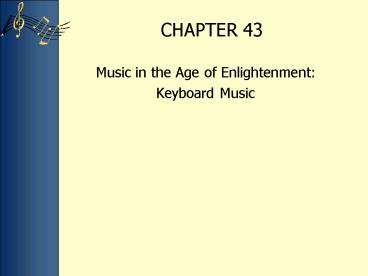Music in the Age of Enlightenment: - PowerPoint PPT Presentation
1 / 11
Title:
Music in the Age of Enlightenment:
Description:
And composers quickly rushed to supply music for this emerging amateur market. ... pieces, in galant style, are not technically difficult and appealed to amateurs. ... – PowerPoint PPT presentation
Number of Views:134
Avg rating:3.0/5.0
Title: Music in the Age of Enlightenment:
1
CHAPTER 43
- Music in the Age of Enlightenment
- Keyboard Music
2
- In his Wealth of Nations (1776), Adam Smith
provides a seminal account of capitalism, an
economic system in which the means of production
of goods are privately owned and bring wealth to
private individuals. At this time, women of the
growing middle-class had the opportunity for the
first time to make music in the home. They did
so with the keyboard. And composers quickly
rushed to supply music for this emerging amateur
market.
3
- To make keyboard music more accessible to the
amateur keyboardist, composers developed several
simple accompanied techniques such as - Alberti bass, which imitates the triad by
playing the notes successively - Murky bass, which provides a rumbling octave bass
4
- Pianoforte invented in Florence around 1700 by
Bartolomeo Cristoforo. The strings of the piano
are not plucked, as those the harpsichord, but
stroked with a hammer that quickly retracts. For
the first time a keyboard instrument could - Play all dynamic ranges from piano to forte
(hence, pianoforte) - An ampler range of articulations like staccato
and legato
5
- Domenico Scarlatti the son of opera and cantata
composer Alessandro Scarlatti, he became
keyboardist to the king of Naples at the age of
fifteen. He then served as keyboardist and music
teacher at the courts in Portugal and Madrid.
Among his compositions, Essercizi probably served
as exercises to develop specific keyboard skills.
- Hand-crossing a keyboard technique in which the
left hand continually crosses over the right to
create a three-level texture. It is one of the
hallmarks of Scarlatti's style.
6
- Acciaccatura Italian for something battered and
bruised. Scarlatti famously makes use of
acciaccatura in the form of crunching downbeat
dissonances before the arrival of a new section.
7
Frederick the Great
- King of Prussia, he was an enlightened leader
with strong interest in poetry and music. At his
court he hosted French philosopher Voltaire, and
composers Johann Quantz and C.P.E. Bach. Every
evening he played flute sonatas and concertos for
two hours.
8
- C.P.E. Bach, the second son of J.S. Bach, worked
at the court of king Frederick the Great in
Berlin. Although he composed in all musical
genres except opera and Catholic Mass, music
keyboard was at the heart of his creative work.
As Quantz had done for the flute before him,
C.P.E. wrote an influential instructional book
for the keyboard titled Essay on the True Art of
Playing the Keyboard. - Empfindsamer Stil a term applied to the
hyper-expressivity that affected northern
European arts in the second half of the
eighteenth century.
9
- Bebung "quaking," a clavichord technique in
which the performer holds and wiggles the key up
and down to produce a vibrating sound. - Fantasia in the eighteenth century a rhapsodic,
improvisatory work, often unbarred, in which the
composers gives free reign the musical
imagination without concern for conventional
musical forms.
10
The Piano Comes to England
- In 1750 the piano was virtually unknown in
England by 1800 it had almost completely
replaced the harpsichord. - Square piano a small box-shaped piano with
strings running at right angles to the keys that
could be placed on a table or a stand. Johannes
Zumpe began manufacturing these popular
diminutive pianos in the 1760s. - Grand piano originally called "grand" to
distinguish it from Zumpe's small pianos.
11
- J.C. Bach the youngest of J.S. Bach's sons, he
first made a living composing operas in Italy and
then moved to London, where he mostly wrote
keyboard pieces. He was the first to publish
keyboard sonatas that indicated the piano on
their title page and to play the piano in public
concerts. His piano pieces, in galant style, are
not technically difficult and appealed to
amateurs. - Bach-Abel concerts a subscription series of
public concerts in London organized by J.C. Bach
and Carl Abel.








![❤[PDF]⚡ Saxophone Colossus: The Life and Music of Sonny Rollins PowerPoint PPT Presentation](https://s3.amazonaws.com/images.powershow.com/10087540.th0.jpg?_=202407290112)






















